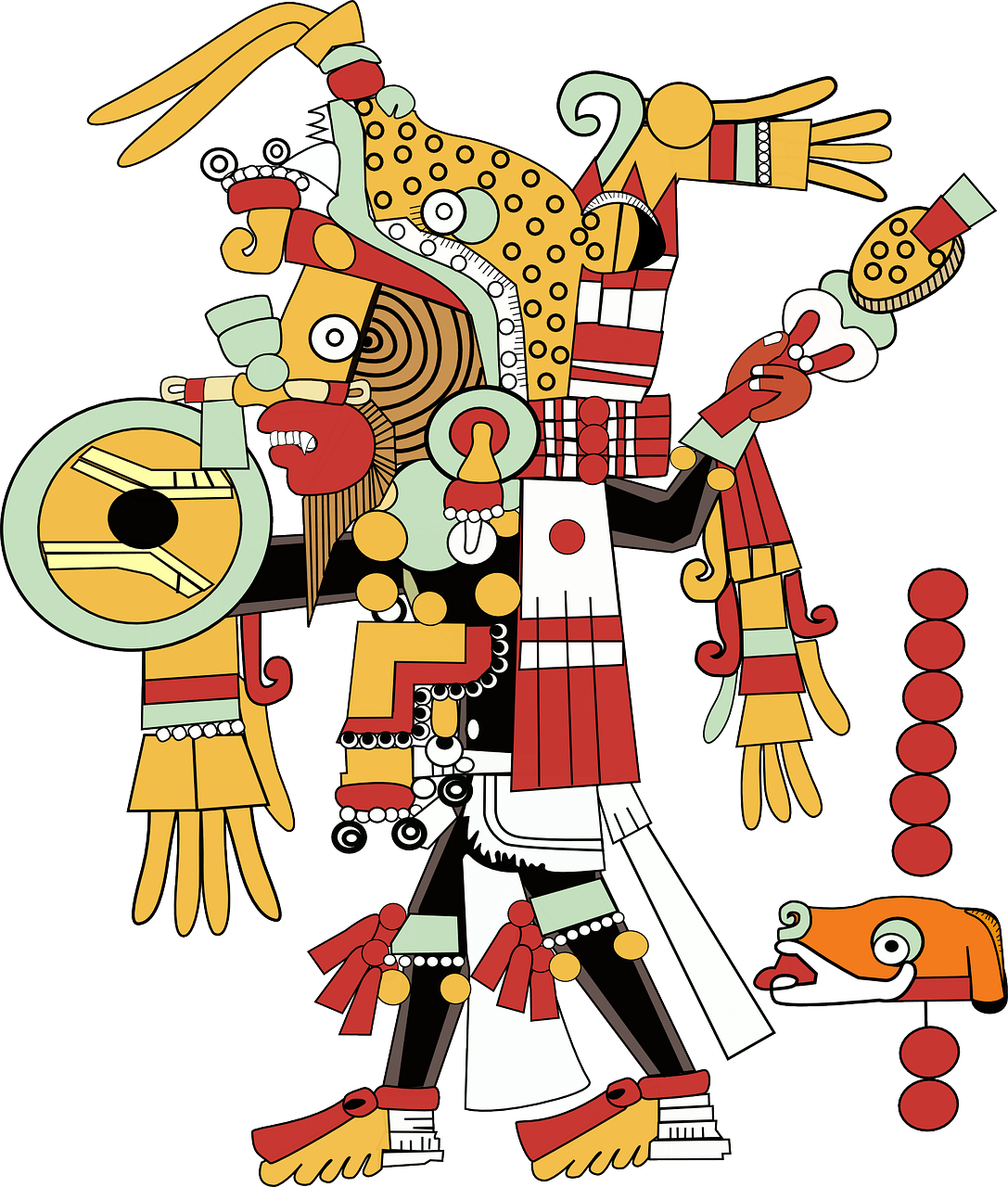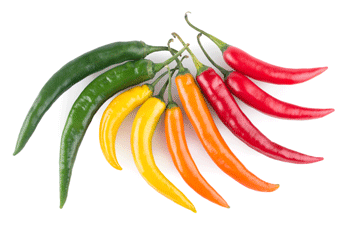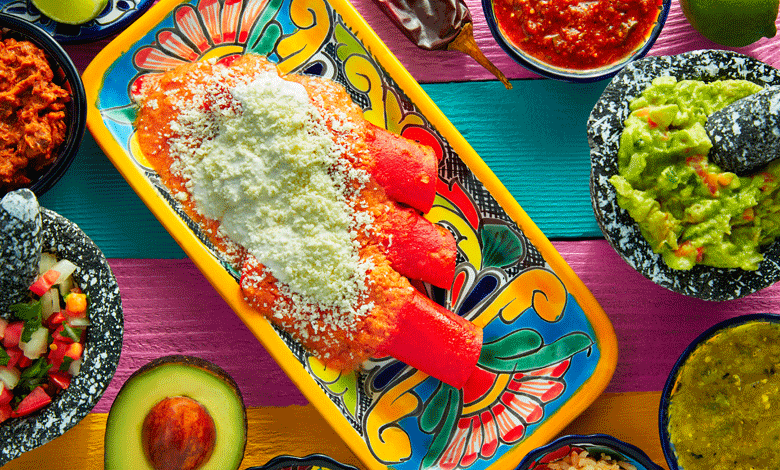The fact that we call Chilis, Chiles or Chillies (in UK English) stems from the word “ Chīlli ” from the Nahuatl language, which says it all. This was the language of the Aztecs before the Spanish conquest of Mexico. When considering that Nahuatl had been and still is (in certain parts) spoken there for 1000s of years before the Spanish invasion of Mexico, it shows just how close the Mexicans are to the very beginnings of the story of the Chilli.

The Aztecs, who were the dominant tribe in Mexico, took the Chilli from an undomesticated native plant and elevated it to a cultivated crop. Their use of Chillies as a vegetable, food seasoning, ingredient for drinks, and medicine meant collecting enough in the wild became impossible. The only way to keep up with the demand for Chillies was to grow them.
While beans, squash and maize played a significant role in the Aztec's diet, Chillies and salt were never far behind. One can only imagine that, in addition to the known Aztez use of the Chilli to make a spicy tomato sauce for Tamales, they would have also used Chillies as a roasted vegetable to season the Acocils (a type of crayfish), wild fowls, gophers ( a burrowing rodent) and deer that they were so fond of eating.
Although the modern Mexican identity has evolved into a different culture from that of the Aztecs, one thing has indeed remained – the love of Chillies in Mexican cooking. Most Mexicans will happily confirm that they are indispensable in their cuisine . Chillies are so popular that more than 150 varieties (from the very mild to explosively hot) are available for just about every culinary purpose. Almost every single Mexican meal contains Chillies in some form or the other, whether as a key ingredient or just when used as a hot sauce, seasoning or in a salad.
Mexican favourites
 There is no doubt that Chillies in Mexican cooking is an essential part of their culture. No meal would be complete without them. Chillies are used fresh, pickled, fried, stuffed, dried, and smoked, in pastes, hot sauces, roasted, as a vegetable, and as a spice and flavouring for hot dishes. In these broad categories, the following are Mexican favourites .
There is no doubt that Chillies in Mexican cooking is an essential part of their culture. No meal would be complete without them. Chillies are used fresh, pickled, fried, stuffed, dried, and smoked, in pastes, hot sauces, roasted, as a vegetable, and as a spice and flavouring for hot dishes. In these broad categories, the following are Mexican favourites .
 Fresh Chillies are used to make dishes like Guacamole Verde (Avocado with tomatillos and Chillies) and Salsa de jitomate (Tomato sauce with Serrano Chillies), Salsa Mexicana (tomatoes with Serrano Chillies, coriander, and onion) and Ensalada tricolour (three-colour salad with Jalapenos)
Fresh Chillies are used to make dishes like Guacamole Verde (Avocado with tomatillos and Chillies) and Salsa de jitomate (Tomato sauce with Serrano Chillies), Salsa Mexicana (tomatoes with Serrano Chillies, coriander, and onion) and Ensalada tricolour (three-colour salad with Jalapenos)
Pickled: Serrano’s and Jalapeños are made into great pickled Chillies, like Chile’s en Vinagre (Chillies in vinegar)
Roasted: Chillies are roasted in dishes like Roasted Poblano peppers, Salsa de Chile Fresco Asado (roasted Chillies with garlic and lime), Chiles Toreados (roasted Chillies with lime and onion) and Huevos Abogados (eggs with roasted poblanos and tomatoes).
Pastes: Great tasting chilli pastes like Ancho- Guajillo paste and Chipotle Chili paste
Stuffed: Chiles poblanos Rellenos (cheese-stuffed Poblano's), Chiles Rellenos de Carne (meat stuffed Chillies) and Chiles en nogada (Chillies stuffed with meat in a walnut sauce).
 Hot sauces and moles: Besides great hot table sauces, great tasting sauces are made to include poultry, seafood, and meat. Examples include Mole poblano (turkey with Chillies, tomatoes and spices), Tortas de Cameron Enrevtijo (prawn cakes in Chilli sauce) and Tamales Rojos de Pollo (red chicken tamales with chilli, onion and tomato sauce). Examples of homemade table sauces include Salsa de Chile Pasilla (Pasilla Chillies with tomatoes and garlic) and Salsa Chimalistac (Ancho Chillies with onion and garlic).
Hot sauces and moles: Besides great hot table sauces, great tasting sauces are made to include poultry, seafood, and meat. Examples include Mole poblano (turkey with Chillies, tomatoes and spices), Tortas de Cameron Enrevtijo (prawn cakes in Chilli sauce) and Tamales Rojos de Pollo (red chicken tamales with chilli, onion and tomato sauce). Examples of homemade table sauces include Salsa de Chile Pasilla (Pasilla Chillies with tomatoes and garlic) and Salsa Chimalistac (Ancho Chillies with onion and garlic).
As a flavouring and spice in hot dishes: Frijoles Puercos (Beans with pork and Habanero Chillies), Frijole Churros (beans with bacon chorizo, pork and green chillies) and Pizotl in Chiltexitjl (pork tenderloin with shrimps and Chillies).
Smoked: Jalapenos are smoked to make Chipotle. These are used to make Adobe sauce (Chillies, tomatoes, sugar vinegar, and spices) used as a marinade for meat, poultry, and seafood.
Fried: Chillies are fried to soften them and release their aromatic oils. An example where this is done includes Huevos Jalapenos (Jalapa style eggs made with Jalapenos)
Besides the above, ground Chillies and powders are used to season and flavour a host of other Mexican dishes.
 As previously mentioned, more than 150 varieties of Chilli are used in Mexican cooking. It would be impossible to include them all, so only the most well-known are listed below:
As previously mentioned, more than 150 varieties of Chilli are used in Mexican cooking. It would be impossible to include them all, so only the most well-known are listed below:
 Jalapeños: Perhaps the best known and most used of all Mexican Chillies. It is a medium-sized Chilli that grows between 4 and 5 inches (50 mm to 60 mm) with a width of approximately an inch (12 mm). Jalapeños are generally picked when still green, but will turn red if allowed to ripen. It has a Scoville rating of between 5000 and 8000 SHU. Uses include pickling, stuffing, and as a fresh ingredient in fresh sauces and guacamole.
Jalapeños: Perhaps the best known and most used of all Mexican Chillies. It is a medium-sized Chilli that grows between 4 and 5 inches (50 mm to 60 mm) with a width of approximately an inch (12 mm). Jalapeños are generally picked when still green, but will turn red if allowed to ripen. It has a Scoville rating of between 5000 and 8000 SHU. Uses include pickling, stuffing, and as a fresh ingredient in fresh sauces and guacamole.
Serrano: The Serrano is widely used in Mexican dishes where a nice bite (without being too hot) is required. It has a Scoville rating of 10000 to 23000 SHU, compared to the hot Birds-eye Chilli at 50000 to 225000 SHU and the mild Jalapeño at about 8000 SHU, which puts it on the scale of being medium hot. It grows to 2 to 3 inches (50 mm to 75 mm) with a width of slightly more than an inch. They are typically picked when green, but will turn red, brown, orange or yellow. It is typically used in dishes like guacamole, salsas, and dips. It also makes a fantastic pickled Chilli.
 Habanero: With a Scoville rating of 100000 to 350000 SHU, the Habanero is definitely one of the hotter chillies used in Mexican cooking. They mature from a green colour to typically red or orange, but white, brown, yellow or purple varieties may be found. They grow to a length of 3- 5 inches (36 mm to 60 mm, and in the region of 2 inches wide. They are typically used to make table hot sauces and salsas, like Chile Tamulado, an extra hot Yucatán style roasted sauce.
Habanero: With a Scoville rating of 100000 to 350000 SHU, the Habanero is definitely one of the hotter chillies used in Mexican cooking. They mature from a green colour to typically red or orange, but white, brown, yellow or purple varieties may be found. They grow to a length of 3- 5 inches (36 mm to 60 mm, and in the region of 2 inches wide. They are typically used to make table hot sauces and salsas, like Chile Tamulado, an extra hot Yucatán style roasted sauce.
Poblano: A mild Chilli that is only slightly hotter than a bell pepper with a Scoville rating of 1000 to 1500 Shu. It is typically used more as a vegetable than as a flavouring or seasoning. It grows to a length of between 3 and 6 inches long (36 mm to 72 mm) and attains a width of roughly 2 to 3 inches (25 mm to 38 mm). Its thick dark green flesh is ideal for roasting and stuffing with cheese, poultry or seafood to make Chiles Rellenos and Chiles en Nogada. They may also be added to stews and Chilis. In its dried form, it is called Ancho Chilli. Anchos are good for spicing up dips and sour cream sauces, but need to be reconstituted by soaking before use. They are also used in making a sauce for Enchiladas.
Cascabel: Literally, the little bell Chilli is also known as the Chile Bola due to its resemblance to a ball. It is a mild chilli with a Scoville rating of between 1000 and 2500 Shu. The Cascabel is mainly used in a dried format with a delicate nutty flavour that works well in soups, salsa, and marinades. It flakes easily and can be used as a seasoning to add exceptional depth of flavour to foods. A favourite in Mexico is a salsa made with this chilli by Cascabel Taqueria Chile sauce.
Chilaca: This mild Chilli is similar to the Poblano in that it has a Scoville rating of only 1000 to 2000 SHU. It is a long Chilli that attains a length of 6 to nine inches. It is slightly curved with a flattened appearance. Whilst they can be picked and used when still young and dark green in colour, they will turn a dark brown if they are allowed to ripen. When this chilli is dried, it becomes a Pasilla chilli. In its fresh form, it is roasted or diced, and added to sauces. It is also pickled. Its dried (Passila) format is used to make hot sauces and used in stews, Moles, and Adobo sauce. In this format, its taste has notes of raisins and liquorice.
Other popular Mexican chillies include the Guajillo, Morito, Mulato, Piquin, Chile de Arbol, and Puya.
Read more ; Recipes from Mexico

